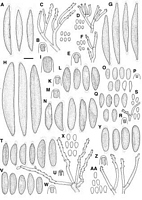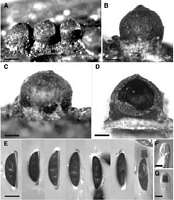|
 Rosellinia chusqueae Rosellinia chusqueae
SynonymsRosellinia chusqueae
BiostatusPresent in region - Indigenous. Non endemic
Images (click to enlarge)
Caption: Fig. 8 A-D, Rosellinia arcuata, PDD 41969: A, Ascospores; B, Ascus apical ring; C,
Conidiophores and conidia on the host; D, Conidiophores and conidia on OA; E-G, R.
freycinetiae, PDD 20580: E, Ascus a | 
Caption: Fig. 10 Rosellinia chusqueae PDD 49483. A-C, Stromata, B showing subiculum remnants at
base; D, Vertical section of stroma, perithecium attached to stroma; E, Ascospores, 4th to |
Article: Petrini, L.E. (2003). Rosellinia and related genera in New Zealand. New Zealand Journal of Botany 41(1): 71-138 (http://www.rsnz.org/publish/abstracts.php).
Description: Subiculum evanescent, white to light brown. Stromata (625)695 ± 48(750) µm high, (550)760
± 146(950) µm wide (n = 5), cupulate with a short cylindrical base, dark brown, black around
the ostioles, solitary. Ostioles finely papillate. Ectostroma to 50 µm thick, black. Entostroma
dark brown, confined to base. Perithecia detached and collapsed in mature material. Ascus
apical rings 6.7- 7 µm long, upper width 4.8-5.6 µm, lower width 3.8-4.8 µm (n = 5), J+, dark
blue. Ascospores (20.1)23.5 ± 1.6(26.4) µm long, (7.2)8.3 ± 0.5(9.6) µm wide (n = 30),
inequilaterally ellipsoidal, dark brown, with sigmoid germ slit running over the whole spore
length, both extremities and flat side surrounded by a slimy sheath, 2-4 µm thick at ends, 1
µm thick at side.
ANAMORPH: Unknown.
Habitat: HOST: Undetermined.
MATRIX: Corticated small twigs.
Notes: NOTES: Contrary to the re-description of the type by Petrini (1993), in which the subiculum
is described as being distinctly brown, the subiculum of the New Zealand collection is of a
lighter colour.
Rosellinia chusqueae differs from R. franciscae L.E.Petrini by its wider ascospores and a
longer germ slit (Fig. 9B). Rosellinia mammaeformis (Pers. : Fr.) Ces. & De Not. and R.
britannica L.E.Petrini, Petrini & S.M.Francis have ascospores with a similar size; they
possess, however, a straight germ slit and their stromata differ in shape and size (Petrini 1993).
|